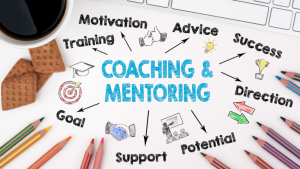
Winning isn’t everything, but developing a winning attitude is required to achieve amazing results, especially in the face of negativity, misperception, and other limiting circumstances. The bonus? It feels great!
However, many people today have conflicted feelings and attitudes about winning. They find it more comfortable to conform to peer pressure, not exceed others’ expectations, and not rock the boat. Unfortunately, this attitude gets in the way of winning for them and their teams. While it keeps them from overshadowing others, there is a huge personal and professional cost (e.g., being overlooked for promotions, not being selected for key opportunities, low self-esteem, confidence, etc.).
Why is having a winning attitude vital for you?
- It creates healthy self-esteem while improving your results.
- It builds your confidence and mindful awareness.
- It provides you the courage to ask for help, hire a coach, and influence others.
- It increases your ability to take the initiative, be coachable, and be resourceful.
- It makes you promotable while having more fun and making more money.
Remember, especially when you want to throw in the towel and say, “I give up,” it’s not about whether you win or lose. It’s about your attitude toward winning. It’s about enjoying the process of gaining new knowledge, skills, and awareness that comes from a winning attitude. And these experiences are priceless.
How to Create a Healthy Winning Attitude
- Do the Work Instead of Creating Excuses. We all love our excuses. But they get in the way of winning! When the process isn’t working, don’t let it deter you from achieving the goal! Don’t change the goal; instead, change the process. Remember, the process rarely looks like you think it should! It requires stretching outside your comfort zone and developing a new one.
- Take Initiative. Too often, people dream the dream but fail to honor the commitments required. They blame other people and situations. Instead, make a good plan and follow it. To achieve any goal, focus on what’s important to you. Now, get in the game and go for it! That’s taking the initiative and getting into focused action.
- When Obstacles Occur, and They Will, Become Resourceful! Everyone hits a wall. Sometimes it’s a massive one. But giving up isn’t an option. Instead, be flexible, resourceful, and resilient. Adopt the winning mantra, “I can do this, and I do it.” Now, take it moment by moment, step by step, and day by day as you move forward. Yes, there will continue to be bumps in the road. But don’t let them stop you.
- Celebrate the Wins with Gratitude, not Ego. When you win, it’s important to celebrate and acknowledge your accomplishments! Add the achievements to your resume and bio. Bragging in a humble manner works! Don’t forget to say, “Thank you!” to those that helped you along the way! (You didn’t achieve it without them!)
©Jeannette Seibly 2021-2023 All Rights Reserved
 Jeannette Seibly is The Leadership Results Coach. She has guided the creation of three millionaires and countless 6-figure income professionals. As an award-winning international executive and family business management consultant, keynote speaker, and author for over 30 years, she guides others to make a positive difference. Feel stuck in a political work situation? Want clear advice on how to get out of it? Contact Jeannette for a confidential conversation.
Jeannette Seibly is The Leadership Results Coach. She has guided the creation of three millionaires and countless 6-figure income professionals. As an award-winning international executive and family business management consultant, keynote speaker, and author for over 30 years, she guides others to make a positive difference. Feel stuck in a political work situation? Want clear advice on how to get out of it? Contact Jeannette for a confidential conversation.
A Note from Jeannette about having a winning attitude and achieving amazing results: Too often, we rely on our excuses for not achieving intended results. The truth is that we need to stop accepting mediocrity and develop a winning attitude. It’s not hard, and there is work to be done. The rewards are: It feels great and can offer external rewards too (e.g., promotion, new home, etc.)! What do you want to accomplish? It’s not too late to get started! Let’s Chat!
 Are you frustrated because you are a results producer and now not producing the intended results? It’s time to find out “why” and get back into the game. It requires seeing your blind spots and hiring a coach! I have extensive experience guiding bosses and leaders to work with and through their teams to achieve unprecedented results. Contact me to learn more about my in-depth, one-on-one coaching program over 13 weeks. Remember, coaching speeds up your ability to win.
Are you frustrated because you are a results producer and now not producing the intended results? It’s time to find out “why” and get back into the game. It requires seeing your blind spots and hiring a coach! I have extensive experience guiding bosses and leaders to work with and through their teams to achieve unprecedented results. Contact me to learn more about my in-depth, one-on-one coaching program over 13 weeks. Remember, coaching speeds up your ability to win.


 Have you considered the benefits of strengthening your superpowers and becoming a great boss? It’s not complicated, but it does require an experienced sounding board. I have extensive experience guiding bosses and leaders to work with and through their teams to achieve unprecedented results.
Have you considered the benefits of strengthening your superpowers and becoming a great boss? It’s not complicated, but it does require an experienced sounding board. I have extensive experience guiding bosses and leaders to work with and through their teams to achieve unprecedented results. 
 Jeannette Seibly is The Leadership Results Coach. She is an award-winning international executive coach, speaker, and business author. Her wisdom of over 30 years guides clients to work through sticky situations and challenging relationships.
Jeannette Seibly is The Leadership Results Coach. She is an award-winning international executive coach, speaker, and business author. Her wisdom of over 30 years guides clients to work through sticky situations and challenging relationships.  Ask your employees to share their ideas! This is a superpower that many leaders fail to develop! Then, they experience turnover, shaky bottom lines, and loss of customers. Working with and through others builds confidence and the ability to influence!
Ask your employees to share their ideas! This is a superpower that many leaders fail to develop! Then, they experience turnover, shaky bottom lines, and loss of customers. Working with and through others builds confidence and the ability to influence! 
 Taking the safe path to avoid uncertainty will never work in your business, career, and life. Develop your superpower and learn how to work through uncertainty. It builds confidence and the ability to influence others!
Taking the safe path to avoid uncertainty will never work in your business, career, and life. Develop your superpower and learn how to work through uncertainty. It builds confidence and the ability to influence others! 
 When you feel like quietly quitting your job, stop! Working through sticky situations and complex relationships isn’t hard if you understand “why!” Your mindset impacts your resilience and ability to achieve intended results! Stop waiting and hoping things will change! It won’t get easier if you wait!
When you feel like quietly quitting your job, stop! Working through sticky situations and complex relationships isn’t hard if you understand “why!” Your mindset impacts your resilience and ability to achieve intended results! Stop waiting and hoping things will change! It won’t get easier if you wait! 
 Have you met a challenge you’ve not been able to work through? Many managers and directors have, and their bosses may not be of much help. Now’s the time to develop your resilience and ability to achieve intended results! Waiting will not make a positive difference.
Have you met a challenge you’ve not been able to work through? Many managers and directors have, and their bosses may not be of much help. Now’s the time to develop your resilience and ability to achieve intended results! Waiting will not make a positive difference. 
 How’s your leadership development progressing? Are you moving forward … or a tad stuck? Do you need a “nudge” or “kick-in-the-butt?” Want to accelerate and soar your results?
How’s your leadership development progressing? Are you moving forward … or a tad stuck? Do you need a “nudge” or “kick-in-the-butt?” Want to accelerate and soar your results? 
 How’s your leadership development progressing? Are you moving forward … or a tad stuck? Do you need a “nudge” and “clarification?” Want to accelerate and soar your results?
How’s your leadership development progressing? Are you moving forward … or a tad stuck? Do you need a “nudge” and “clarification?” Want to accelerate and soar your results? 
 Announcing New Workshop! Traditional leadership (e.g., formal, metrics-driven) is being replaced with human leadership (e.g., focus on the human dynamics that impact results). For example, “That’s how it’s always been done.” vs. “Great idea. How do you recommend we implement it?” However, your managers and directors are being overlooked regarding the training required to be an effective boss and leader. Read about my newest workshop:
Announcing New Workshop! Traditional leadership (e.g., formal, metrics-driven) is being replaced with human leadership (e.g., focus on the human dynamics that impact results). For example, “That’s how it’s always been done.” vs. “Great idea. How do you recommend we implement it?” However, your managers and directors are being overlooked regarding the training required to be an effective boss and leader. Read about my newest workshop: 
 This week’s PODCAST: Listen to Want to Achieve Great Results? Use Peer Coaching with my guest, Meredith Bell, on
This week’s PODCAST: Listen to Want to Achieve Great Results? Use Peer Coaching with my guest, Meredith Bell, on